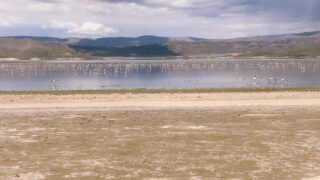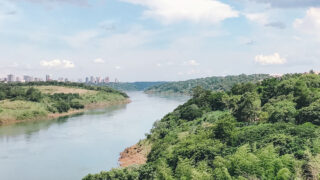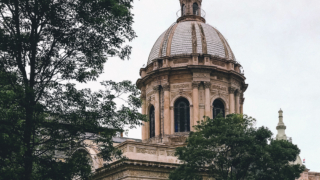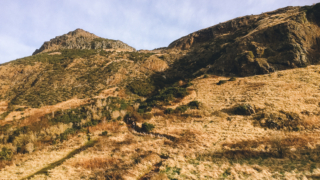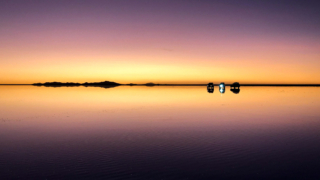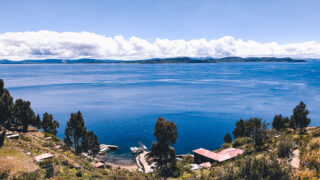No matter if you are backpacking South America or if you are on a short trip to visit Machu Picchu after this read you will have found the perfect route for you. Trust me, there is a way to experience the abandoned Incan citadel for every type of traveller. Whichever you choose the venture will leave you with the feeling of having visited an inspiring place with a radiant energy that can’t be put into words. Not by me anyway!
Machu Picchu can be reached in not one but 5 different ways. From a thrill-seeking adventure of mountain-biking down winding mountain roads, water rafting, and zip-lining over the cloud forest; passing through the Sun Gate while the first sun rays of the day illuminate Machu Picchu in all it’s glory. Or perhaps a trail guiding you past dramatic landscapes, bright turquoise lakes and lagoons, and coffee fields; or to medicinal hot springs, an energy healing waterfall, the pink salt Maras and an Incan village is for you? Anyone rushed for time or wanting to reach Machu Picchu with minimal effort can travel to Aguas Calientes by train.
Trying to figure out what trail to choose, how to get to Machu Picchu by train and bus, and where to stay in Aguas Calientes? Read on to find out.

Post Contents
THE MACHU PICCHU CITADEL
Whatever path you choose, apart from the train or the Inca Trail, your final day will rob you of the last bit of energy when conquering the steep 1,600 steps from Aguas Calientes to Machu Picchu.
Both the morning and afternoon entrance tickets allow you to explore the grounds for up to 4 hours. This includes climbing Huayna Picchu which can be purchased at an extra cost in advance. During the guided tour of the citadel, you are guaranteed to learn about the Inca’s rituals and cultivation.

The guides included in your tour or readily waiting to be approached by one-day visitors are ready to answer any questions. Our guide overrun on the allocated time slot to feed or desire to learn more. You might even find guides joking about the Incas responsibility for the lack of beautiful people in Peru. The Incas used to sacrifice the most beautiful children of non-Inca families. Unimaginable right?!
What makes the great citadel built by the Incas in the 1400s so special is that it was never discovered by the Spaniards and therefore is at a relatively good condition. Machu Picchu was only discovered in the early 20th century before becoming the second most popular tourist attraction in the world.
The awe-inspiring ground the citadel is built on is sinking. To protect the World Wonder the amount of daily visitors are limited to 5,940 people. This regulation will become more restricted in the future making the already highly demanded entry tickets even more scarce. Therefore, plan ahead and choose a morning or afternoon ticket wisely. In general, the morning is deemed to offer better views. My experience was the contrary with fog covering the famous site until midday (January).
THE FOUR MACHU PICCHU TRAILS
The Adventure Trail: Inka Jungle.

Difficulty: Intermediate
Duration: 4 Days
Distance: 45 km/ bike & 28 km trek
Cost: USD 135 – 170
Return: Minivan/ Train & Bus
Always looking for the next thrill? Then the Inca Jungle trek is the one for you. Your adventure will begin with a 2.30-hour mountain bike ride downhill a scenic mountain road. Followed by rafting if the current allows or alternatively a coffee tour. The thrills don’t stop there. After having spent the night in a guesthouse you will hop onto four zip lines acting out different poses in dizzying heights.
On the third day, all your dreams of an unchallenging trip to Machu Picchu will be shattered when you embark on a 7-hour trek through jungle and winding narrow mountain paths with magical valley views, reaching up to 4,316-metres in altitude. Before leading you onto the train treks towards Aguas Calientes for a dip in the thermal baths.
All three nights will be sent in a hostel/ guesthouse with showers. On the second night you might even stay in a party hostel.
Tip: There is no rafting between January & March.
In The Incas Footsteps: The Inca Trail.

Difficulty: Intermediate
Duration: 4 Days
Distance: 43 km/ 27 miles
Cost: USD 699 – 1,900
Return: Train & Bus
Did looking at the price blow your socks off? This trail is out of any budget-conscious traveller’s price range. Although, this rightfully is one of the most famous treks on Earth. Or so I am being told anyway. Due to permits being required and a restriction of 200 tourists a day this trek can only be completed with a guide.
Your time trekking the most famous South America trail will begin 40-minutes from Ollantayatambo. The four-day trek guides you along steep, narrow, winding paths across the Andes Mountains, past ancient ruins, through cloud forest surrounded by birdsong. What makes this trail unique is the Inti Punku, better known as the Sun Gate. Only on this trail you can experience the warm sunbeams of the rising sun striking your skin as you are passing one of the Seven New Wonders, the Sun Gate.
On this trek all your nights will be spent in two-man tents under the star-riddled sky. Tours include a guide, porters carrying the equipment and food, two-person tents and sleeping bags. Be prepared for the unpleasant outdoor squad toilets. On a positive note, the porters will set up and take down the tents for you.
The Cheapest Trail: Salkantay.
Difficulty: Intermediate
Duration: 4 – 5 Days
Distance: 74 km/ 46 miles
Cost: US$150 to US$500
Return: Minivan/ Train & Bus
This four- or five-day hike is the cheapest trekking option and can be booked last minute. This is also the only trek that can be done without a guide since no permit is required. Although the price difference is marginally favourable. However, if you want to complete this trek independently you should purchase an entrance ticket to Machu Picchu in advance.
This trail is perfect for advocate hikers with daily hikes taking 1.30-hours to 9-hours. The path will guide you past the deep blue Salkantay Lake in midst of dramatic mountainous landscapes reaching an altitude of up to 4,630-metres, the bright turquoise Humantay Laguna, through rich coffee fields, to a dip in the hot water springs of Aguas Calientes. Thrill-seekers can hop on four ziplines through the tropical cloud forest at an extra cost.
If you opt for a guided trek you will be provided with the camping equipment, a cook, and horses transporting the food and camping equipment. The trek also includes one night in a hostel in Aguas Calientes.
There are guesthouses and campsites along the trail for unguided hikers not only offering a place to rest your head but most also breakfast, dinner, and occasionally packed lunches. And anyone tired of carrying their equipment can rent a mule.
The Most Versatile Trail: Lares Trek.

Difficulty: Intermediate
Duration: 4 Days
Distance: 33 km/ 20.5 miles
Return: Minivan/ Train & Bus
Unlike the other trails this four-day adventure begins with a reward, a dip in the medicinal Lares’ hot springs. The hard work begins on day two with a hike through the Valley of Quiswarani marvelling at snow-capped mountains and turquoise lakes. Followed by conquering the 4,700-metre Pachacutec Pass to the Qanchispaccha waterfall for energy cleansing. This versatile trek will then guide you to the beautiful pink salt of Maras and populated Inca city Ollantayatambo before reaching Aguas Calientes from where you will hike to the Incan Fortress Machu Picchu on your final day. The daily hours of hiking are between 1.30-minutes to 8-hours.
You will be provided with the camping equipment, a cook and horses transporting the food and camping equipment. The trek also includes one night in a hostel in Aguas Calientes and ziplining at an extra cost.
MACHU PICCHU BY TRAIN

Difficulty: Easy
Duration: 1 – 2 Days
Cost: from USD 185 return (inc. entrance fee)
Simply want to tick a World Wonder of your bucket list without breaking into a sweat? I don’t blame you! The famous site can be accessed by train as a full day round trip. I suggest checking the weather forecast. Clear skies will make or break your experience without having the trail highlights make up for a fog covered Machu Picchu.
There are two train companies to choose from Inca Rail and Peru Rail with prices being in line if you book in advance. Trains depart from Poroy (Inca Rail only), Urubamba (Peru Rail only) and Ollantaytambo. The latter can either be reached by local bus from Cusco or a bus/ train combo ticket can be purchased for convenience.
The Machu Picchu train station is in Aguas Calientes from where you continue by bus for 20-minutes for an additional USD 24 one-way. For an added challenge climb the 1,600 steps for 1.30-hour to the entrance of the citadel. To make the most out of your experience I suggest spending a night in Aguas Calientes. The town, although brimming with tourists, is surprisingly charming and energetic.
WHERE TO STAY IN AGUAS CALIENTES
Ecopacker Hostel.
This is one of the only backpacker hostels in town and even has a bar. It is also one of the cheapest hostels in town with sister branches in Cusco and Lima. Santuario Historico Machu Picchu, Peru, Av Imperio de los Incas 136, Aguas Calientes
Don Andre Hostal.
We stayed at this hostel as part of the tour package. This place is a no thrills kind of place where you can rest your head for the night and have a well-deserved hot shower. The four beds are quite cramped, but the beds are comfortable. Santuario Historico Machu Picchu, Ca. Wuyñay Wayna C-12, Aguas Calientes 08681
WHERE TO BOOK YOUR MACHU PICCHU TRIP
Tickets can be purchased in advance online at a higher price. Although I suggest shopping around in Cusco for the best price. I booked the Inca Jungle Trail through Wayna Peru Expeditions. Although, we had paid the least out of the group I do have to admit my disappointment that they failed to mention that rafting was off the table. Some other agencies are SAM Travel Peru, Viajes Cusco, Alpaca Exhibitions, and AB Expeditions.
BEST TIME TO VISIT MACHU PICCHU
The best time to visit Machu Picchu is in April and May if you want to avoid crowds but still enjoy the mountains in all their emerald glory. May to October is mostly clear and dry. July and August see the most crowds outside of festivities of Inti Raymi at the end of June. The rainy season is in January and February. I visited in early January and although we had sunshine throughout most of our days trekking we experienced flooded paths, mudslides, and a sea of bright coloured ponchos wandering around fog-covered Machu Picchu citadel.

ALTITUDE
Altitude sickness can be a real b**ch. At 2,430 metres Machu Picchu is lower than Cusco. Anyone who has acclimatised already will not have any issues. Bear in mind that the Salkantay Trail will reach altitudes of 4,700 metres. I would still have some coca tea and leaves handy to avoid headaches and make sure to drink more water than usual.
WHAT TO PACK
Pack light! Your back will thank you for it. The varying temperatures in the mountains mean you need to come prepared with short and long trousers, and layering pieces. I highly recommend a rain jacket and cover for your bag. Sun cream and mosquito repellent even during rainy season.
Porters carry purified water and snacks, unless you are hiking Inca Jungle Trek on which water can be purchased along the way.

GOOD TO KNOW
Check the weather and ask fellow travellers about the conditions they have experienced. The weather does not only have an impact on the view of Machu Picchu and its surrounding mountains but also trekking safety. When I visited in early January we experienced mudslides and flooding. Groups leaving camp later than us had to be picked up by a minivan and taken to Aguas Calientes instead of being able to enjoy a full day of hiking.
There is no rafting from January to March due to strong currents.
Solo travellers will have to share their tent with a stranger. Way to make a friend for life am I right?
The entrance fee for Machu Picchu and Machu Picchu Mountain is SOL 200. Generally speaking, the morning ticket is deemed to offer better views.
Visiting Huayna Picchu.
Be mindful of adding Huayna Picchu to your itinerary. Make sure there is enough time for the round 1.30-hour hike to the summit and return. Our ticket was the 6 am entrance, with Huyana Picchu Mountain entrance at 7 – 8 am. If we would have chosen to hike up the mountain we would have only had about 15 minutes on top before having to return all the way to the bus collection point at 12 am.
WHERE TO NEXT
Heading back to Cusco for partying and all there is to do that isn’t Machu Picchu or the Rainbow Mountains? Or perhaps you plan on continuing your journey along the Inca trails to Lago Titicaca.
Did I do a good job of creating excitement for this ancient citadel? Have you chosen a trail yet? Let me know in the comments.
Now go ahead and explore! Try not to lose your towel.










